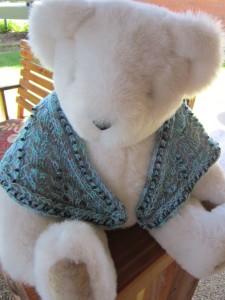You can use this outline for upsizing the doll-size pattern to child size or even adult size.
Wouldn’t it be great to make coordinating doll and child size shawls for a daughter/grand-daughter/niece/etc.?
Because of the top-down triangle shawl shape, making an adult size (or any size) from Dolly’s Top-Down Tri Shawl is quite easy. Here’s how.
Going Forward Confidently
If you are new to knitting full-size shawls, you can use the doll-size pattern instructions as is to make a small sample-size shawl while getting comfortable with your yarn, stitch pattern and techniques. As a practice piece, even if you have a boo-boo or two, dolly won’t mind. This practice piece will make knitting a larger shawl less intimidating and give you confidence. Also, the completed sample size shawl makes a terrific gift for a doll or teddy bear lover.
Repeat the Stitch Multiple
Because of the structure of this type of top-down shawl, you can just continue to repeat the pattern stitch multiple as needed within each side panel section until the length needed less the ending bind off edging. In Dolly’s Top-Down Tri Shawl, the stitch multiple is 7 stitches (indicated by the heavy lines in Chart 2 of my HeartStrings pattern).
Tip: Since lace is usually stretched out a bit (or a lot depending on your choice) for blocking, you’ll want to take this into account in measuring your pre-blocked length.
How Much Yarn?
Obviously you will need more yarn for a larger size (and beads if you are using them as in this pattern). Here are some guidelines for different weight yarns and sizes –
|
FINISHED LENGTH FROM TOP OF CENTER-BACK NECKLINE TO LOWER POINT OF TRIANGLE |
|||
|
YARN TYPE |
36 – 40” full-length shawl |
24 – 30” shawlette or mid-length shoulder shawl |
18” neckerchief |
|
Lace weight |
1250 – 1525 yards (1150 – 1400 m) |
550 – 850 yards (500 -775 m) |
300 yards (275 m) |
|
Fingering weight |
1000 – 1250 yards (925 – 1150 m) |
450 – 700 yards (400 – 650 m) |
250 yards (225 m) |
|
Sport / DK weight |
900 – 1100 yards (825 – 1000 m) |
400 – 625 yards (350 – 575 m) |
225 yards (200 m) |
|
Worsted weight |
800 – 1000 yards (725 – 925 m) |
350 – 550 yards (325 – 500 m) |
200 yards (185 m) |
Tip: Of course, if you are limited in the amount of yarn you have, you want to have enough to finish to within whatever length of yarn you have. To anticipate this, you can use the rule-of-thumb that a bindoff edging that is attached to the main body of the shawl every other row (as is done for Dolly’s Top-Down Tri Shawl) will take about the same amount of yardage as
(the number of stitches in the edging) * (2 rows of the last completed main body rows)
For this dolly shawl pattern, the edging is 6 stitches. So the edging will take:
6 stitches * 2 rows = the last 12 rows of the of the main body of shawl (to be safe, just figure the last 2 repeats which will round up to 14 rows).
Knitting Needle Suggestions
Use a circular needle to comfortably hold the large number stitches on the cable that will eventually be needed for the width of the shawl. This centers the weight of the project and avoids wrist stress.
I suggest a circular knitting needle 24 – 32” in length (or possibly more for very large sizes if you have a 40″ length available) that is 3 to 4 sizes larger than suggested on your yarn’s label (or see guidelines below).
Note: Since the top-down triangle shawl begins on just a few stitches and increases from there, you can start with a short circular knitting needle (or even a pair of straight needles) and then use increasingly longer circular needles as the number of stitches increases.
Needle Size Guidelines
For lace weight yarn, use US 4 or 5 (3.5 – 3.75 mm)
For fingering weight yarn, use US 6 or 7 (4 – 4.5 mm)
For sport or DK weight yarn, use US 8 or 9 (5 – 5.5 mm)
For worsted weight yarn, use US 10 or 10½ (6 – 6.5 mm)
Wrapping up
I hope this Extra Bonus article helps you enjoy your Dolly’s Top-Down Tri Shawl even more by also knitting an up-sized shawl in the future. This completes the June BOBBOL 2013 knit-along. Watch for the upcoming July KAL soon! (Hint: Think Christmas in July and knitting with beads in colorful ways.)



 HeartStrings FiberArts
HeartStrings FiberArts Knitting Bits of Lace on Facebook
Knitting Bits of Lace on Facebook Ravelry Store
Ravelry Store